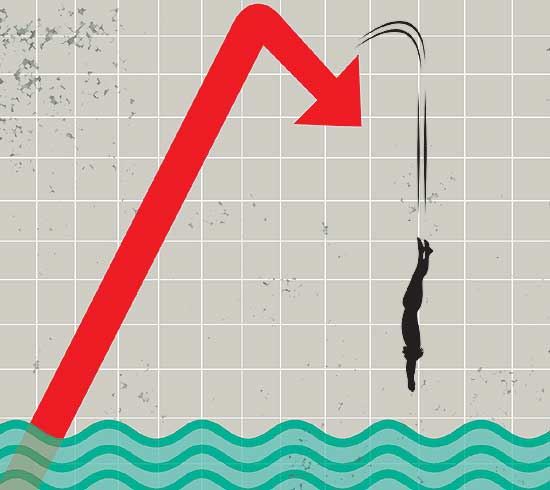
These are turbulent times once again. With bad news trickling in from Europe, the US, China and now the two Korean nations, the markets are reacting and stocks are coming down. Investors are experiencing a fall in their portfolios and memories of the 2008 meltdown have come alive once again.
So, now, it is time to check our own behavioural biases. It is important to understand our feelings when we are confronted with losses and how those feelings can affect our behaviour and distort decision-making. As far as our feelings towards losses are concerned, we tend to suffer from two strong behavioural biases: loss aversion and sunk cost fallacy.
Loss aversion. It has been proved that the pain of loss is three times more than the pleasure of an equal amount of gain. While loss becomes terrifying over time, pleasure becomes boring. This loss aversion has a direct bearing on our investment decisions. However, if one is aware of these biases, they can be used to one’s advantage. Loss-averse investors are prone to the following behaviour.
- When markets crash, they sell stocks and flee to safety. Or, they buy fixed income securities.
- They sell winners and hold on to losers. Their portfolios normally have a couple of winners followed by a long list of losers.
- They take profits very early.
- They take more risks when threatened with a loss. This is the Gambler’s Fallacy.
- They are tax-averse. They hate to pay taxes and for that, they are even willing to forego profits.
From their behaviour, it is evident that such investors are not risk-averse but loss-averse. Evidence shows that such investors will increase their risk to avoid the smallest
probability of loss.
probability of loss.
Sunk cost fallacy. You increase your commitment to justify your past actions. Averaging the cost of purchases by buying more when you have gone wrong on your stock selection, or spending indefinitely on repairs when the asset needs replacement are glaring examples of sunk cost fallacy. Banks are a good case in point. They lend to undeserving, old borrowers as they have already lent them. The question they should be asking themselves is: “Is the business viable enough to merit a further loan?” However, sunk cost fallacy makes them think: “If we have already lent them, we should do so again.” Good money goes after bad money.
|
God forbid, should the monsoon be delayed, markets could see more turbulence. This could lead to high loss aversion. Investors need to understand that with the Indian growth story intact and very few investment opportunities available to foreign institutional fund managers, India is still the most preferred destination. Such times could offer great investment opportunities. So, refrain from the impulsive flight to security of fixed income instruments.
On the contrary, if stocks are falling, your money should go towards buying the right ones. Stocks are your best hedge against inflation.Don’t sell your winners on the fear that markets will tank. And, do not hold on to your losers in the hope that prices will go up. When you sell your non-performers, the loss is adjusted against your profits. Re-frame losses as gains and have wholesome portfolio vision. Not looking at gains and losses in isolation will give you a lot of psychological comfort. Finally, do not track your investments as if they mean the world to you. There is no need to worry if you have made the right decisions and are guided by the right portfolio manager. To have a thorough understanding of loss aversion, please visit www.ppfas.com and under ‘Understanding Behavioral Biases’ go to ‘Feelings Towards Losses’.

No comments:
Post a Comment